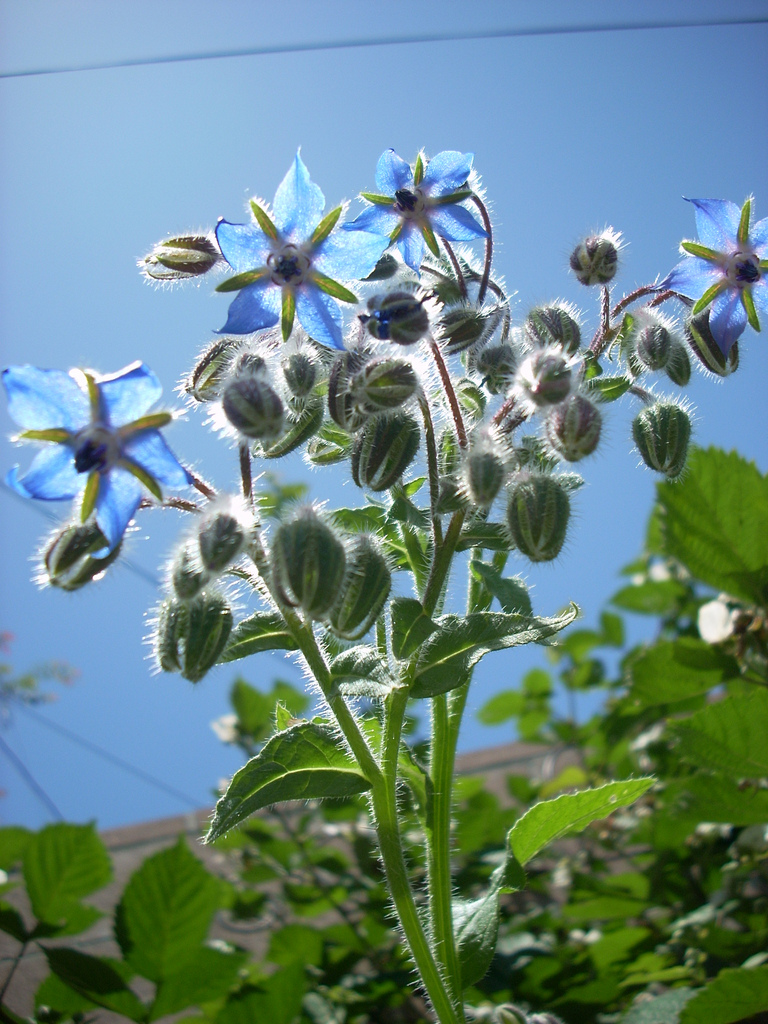- Borage
Taxobox
name = Borage

image_width = 240px
image_caption = Borage flower
regnum =Plant ae
divisio = Magnoliophyta
classis = Magnoliopsida
ordo =Lamiales
familia =Boraginaceae
genus = "Borago "
species = "B. officinalis"
binomial = "Borago officinalis"
binomial_authority = L.Borage ("Borago officinalis" L.), also known as "starflower" ( [http://seed.blogfa.com/post-31.aspx گل گاوزبان ایرانی] is Echium amoenum ) is an annual
herb originating in Syria, but naturalized throughout the Mediterranean region, as well as Asia Minor,Europe , North Africa, and South America. It grows to a height of 60-100 cm (2-3 feet), and is bristly or hairy all over the stems and leaves; the leaves are alternate, simple, and 5-15 cm (2-6 in) long. Theflower s are complete, perfect with five narrow, triangular-pointed petals. Flowers are most often blue in color, although pink flowers are sometime observed. White flowered types are also cultivated. The flowers arise along scorpiod cymes to form large floral displays with multiple flowers blooming simultaneously, suggesting that borage has a high degree of geitonogamy. It has an indeterminate growth habit which may lead to prolific spreading. In milder climates, borage will bloom continuously for most of the year.Characteristics and uses
Traditionally borage was cultivated for culinary and medicinal uses, although today commercial cultivation is mainly as an oilseed. The seed oil is desired as source of
gamma-linolenic acid (GLA, 18:3, cis 6,9,12-octadecatrienoic acid), for which borage is the highest known plant-based source (17-28%). The seed oil content is between 26-38% and in addition to GLA contains the fatty acidspalmitic acid (10-11%),stearic acid (3.5-4.5%),oleic acid (16-20%),linoleic acid (35-38%),eicosenoic acid (3.5-5.5%),erucic acid (1.5-3.5%), andnervonic acid (1.5%). The oil is often marketed as "starflower oil" or "borage oil" for uses as a GLA supplement, although healthy adults will typically produce ample GLA through dietary linoleic acid.Borage production does include use as either a fresh vegetable or a dried herb. As a fresh vegetable, borage, with a
cucumber like taste, is often used in salads or as a garnish. The flower, which contains the non-toxicpyrrolizidine alkaloid thesinine , has a sweet honey-like taste and is one of the few truly blue-colored edible things, is often used to decoratedessert . It is notable that the leaves have been found to contain small amounts (10 ppm of dried herb) of the liver-toxic pyrrolizidine alkaloids:intermedine ,lycopsamine ,amabiline andsupinine .Vegetable use of borage is common in Germany and the Spanish regions of
Aragón andNavarra . Although often used in soups, one of the better known German borage recipes is theGreen Sauce (Grüne Sauce) made inFrankfurt . The leaves and flowers were originally used inPimms before it was replaced by mint. Naturopathic practitioners uses of borage for regulation of metabolism and the hormonal system, and consider it to be a good remedy forPMS andmenopause symptoms such as thehot flash . Borage is sometimes indicated to alleviate and heal colds, bronchitis, and respiratory infections in general for itsanti-inflammatory and balsamic properties. The flowers can be prepared in infusion to take advantage of its medicinal properties. The oleic andpalmitic acid of borage may also confer a hypocholesterolemic effect.Tea made from the dried flowers is a traditional calming drink in
Iran (Echium amoenum ). It has a rich purple color that turns bright pink by adding a few drops of lemon juice.Fact|date=February 2008See also
*
Flower
*Herb
*List of repellent plants
*Plant External links
* [http://www.growingherbs.org.uk/herbs/how_to_grow_borage.htm How to Grow Borage]
* [http://www.hort.purdue.edu/newcrop/nexus/Borago_officinalis_nex.html Purdue University Center for New Crops & Plant Products]
* [http://www.uni-graz.at/~katzer/engl/Bora_off.html Gernot Katzer's Spice Pages]
* [http://www.maltawildplants.com/BORG/Borago_officinalis.php Comprehensive profile for "Borago officinalis" from the website MaltaWildPlants.com]References
Wikimedia Foundation. 2010.
